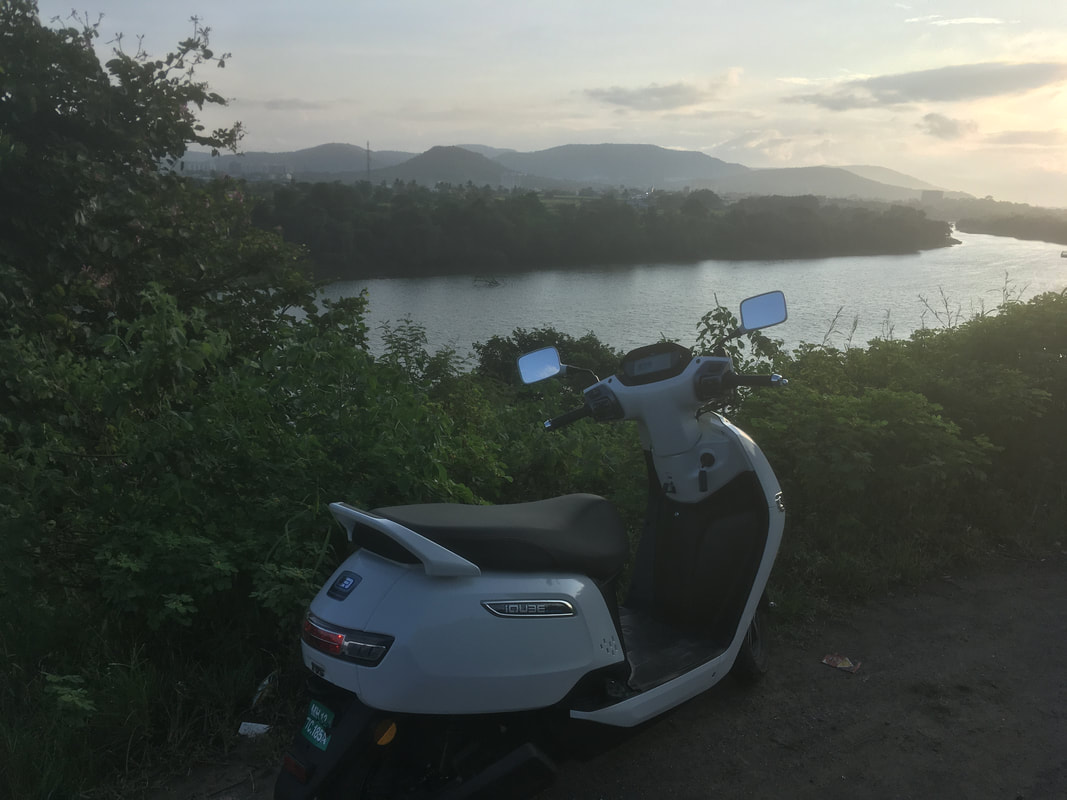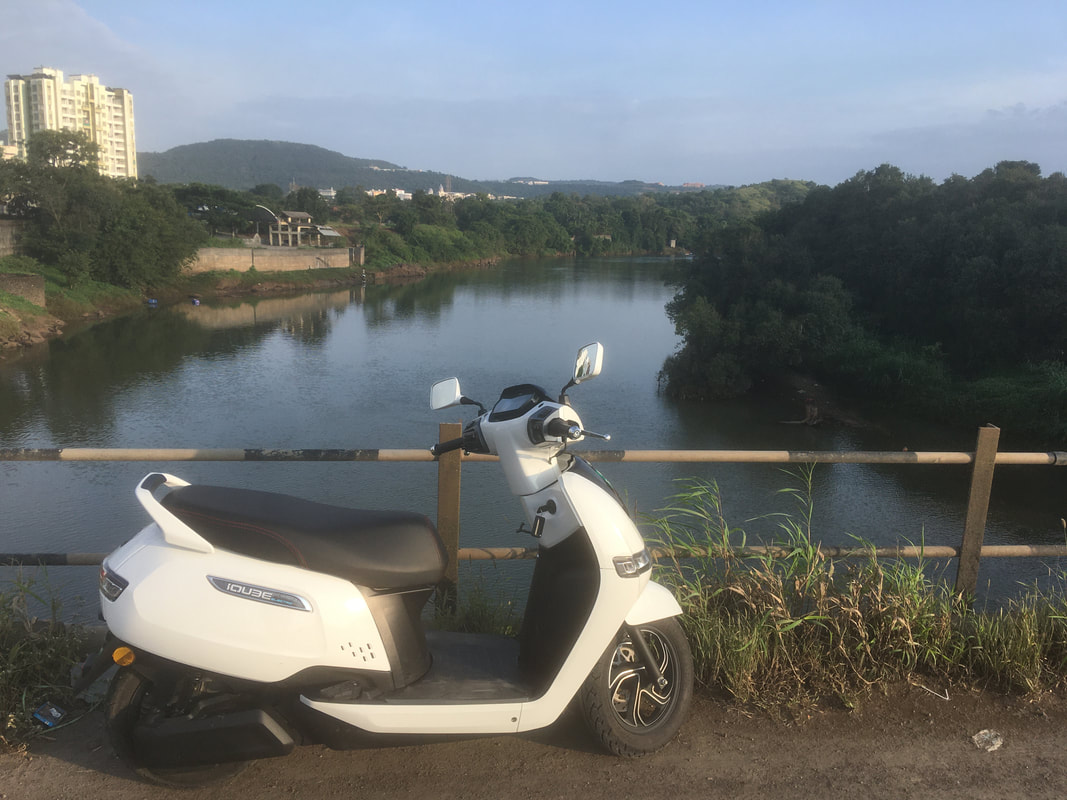By Atul Gopal
The PluginIndia team had an opportunity to test the iQube electric scooter from TVS Motors. Here are our findings after riding it for close to 250 km. Here are our findings on the build quality, ride, battery specification and range you can expect.
Video: Let's Ride : TVS iQube Electric Scooter | हिंदी Subtitles
We picked the vehicle up from the TVS service center at Parvati Industrial Estate. Went straight to the market yard from there for some wholesale fruit purchase. The vehicle is quite rugged - and can take up all that you can load on it. The 2.2 kW hub motor is powerful enough to take the fully loaded vehicle up most city inclines at speeds upwards of 30 kmph. The finishes meet the higher standards of the ICE industry. In terms of specifications, TVS has almost tried to match the Jupiter. Comfortable suspension. Sedate styling. Good dicky space. USB charger for phone inside the dicky. The inside beauty impressed me more than the outside: no dangling cables. Like a good detective, it is ordinary enough not to get noticed when it is busy chasing ICE scooters. Yet, people do look at the TVS badging and on noticing the absence of an exhaust, you get the takia kalam question - battery wali?
The vehicle weight distribution is done quite well. My big issue, like I discussed in my last blog of the iQube, is the overall weight. I think TVS has used components from its existing inventory of ICE scooters, and have ended up with a scooter in the heavyweight category of EVs. I have gotten so used to lighter vehicles, that manipulating the 118 kg beast in parking is a challenge. To the iQube's credit, it does have an interesting parking mode - for both forward and reverse. The higher weight also makes the steering a wee bit heavy - and at low speeds you tend to drive in a slight zig zag fashion. But the real worry caused by weight is not this, but the range.
We got a range of only 68 km with mixed drive modes, but mostly single seat Economy mode. The biggest culprit for the low range is of course the weight. I have a feeling that the iQube is over-engineered - thanks to its ICE pedigree. You definitely don't need that heavy a body to support a 2.2 kW motor and a 2 kWh battery pack. TVS folks, please look at putting the iQube on a dieting program asap. The low hanging fruit for range beef up is battery pack size. TVS can easily up the battery size to about 3 kWh. With FAME 2 subsidy dependent on battery pack size, this will sit easy on the pockets of the customer.
The vehicle weight distribution is done quite well. My big issue, like I discussed in my last blog of the iQube, is the overall weight. I think TVS has used components from its existing inventory of ICE scooters, and have ended up with a scooter in the heavyweight category of EVs. I have gotten so used to lighter vehicles, that manipulating the 118 kg beast in parking is a challenge. To the iQube's credit, it does have an interesting parking mode - for both forward and reverse. The higher weight also makes the steering a wee bit heavy - and at low speeds you tend to drive in a slight zig zag fashion. But the real worry caused by weight is not this, but the range.
We got a range of only 68 km with mixed drive modes, but mostly single seat Economy mode. The biggest culprit for the low range is of course the weight. I have a feeling that the iQube is over-engineered - thanks to its ICE pedigree. You definitely don't need that heavy a body to support a 2.2 kW motor and a 2 kWh battery pack. TVS folks, please look at putting the iQube on a dieting program asap. The low hanging fruit for range beef up is battery pack size. TVS can easily up the battery size to about 3 kWh. With FAME 2 subsidy dependent on battery pack size, this will sit easy on the pockets of the customer.
The other improvement that TVS can do to improve on range is a relook at the aggressive regen. The iQube works only on two modes - acceleration and deceleration. Newton's first law states that a body in rest will continue in a state of rest and a body in motion will continue in its state of motion - unless some force is applied to it. This means that the iQube powerplant is constantly at work - most times as a motor, sometimes as a generator. Though the regen means that you hardly have to use the brake - it also means that you are using a lot of excess energy in braking and accelerating, when you should have been coasting. The thumb rule is that even the most efficient of motors can only capture 50% of the energy in regen, so you are actually better off allowing it to coast rather than decelerate. Since this is mostly a function of software calibrations, TVS can act on this right away.
Another request would be to have a power bar on the display to show how efficiently (in wH/km) the scooter is being ridden. This is a good visual cue for the rider to help reduce energy usage - and thereby increase range. And continuing on the subject of software, there can be better communication on the range front. Once the range dips below 5 km, the display for range on the TFT goes blank. All you get is a blinking red battery light. Very soon this blinking transforms to a fully switched on light. And then in the middle of the driving - the vehicle just stops. I wonder why TVS did not progressively cut off speed as battery charge reduces. Was able to drive on Sports mode even with range dipping to less than 5 km. I think having a creep mode speed of 10 kmph when the battery SOC dips into single digits makes a lot of sense.
In the meantime, there is a sweet spot on the accelerator, about a 10 degree rotation where coasting does happen. If you use that, I suspect you can get the claimed 75 km range - or insha allah even 80 km. Will need to try this in a separate range test. For some strange reason TVS is not supporting fast charging. I think this is to get good battery life. But for a vehicle that is already handicapped by range, fast charging is a must. Again, it is not going to take too much to engineer that. In the absence of a fast charger, I had to spend half of my first day of testing, waiting for the battery to charge up. At 6.5 hours it does take a super long time to charge up.
All in all an excellent product by TVS. We have an EV option from TVS at last. We only wish we had additional range...
Footnote: The vehicle we received would go into an annoying resonance at 15 kmph. We tried another iQube and found that this problem was peculiar only to our test vehicle.
Another request would be to have a power bar on the display to show how efficiently (in wH/km) the scooter is being ridden. This is a good visual cue for the rider to help reduce energy usage - and thereby increase range. And continuing on the subject of software, there can be better communication on the range front. Once the range dips below 5 km, the display for range on the TFT goes blank. All you get is a blinking red battery light. Very soon this blinking transforms to a fully switched on light. And then in the middle of the driving - the vehicle just stops. I wonder why TVS did not progressively cut off speed as battery charge reduces. Was able to drive on Sports mode even with range dipping to less than 5 km. I think having a creep mode speed of 10 kmph when the battery SOC dips into single digits makes a lot of sense.
In the meantime, there is a sweet spot on the accelerator, about a 10 degree rotation where coasting does happen. If you use that, I suspect you can get the claimed 75 km range - or insha allah even 80 km. Will need to try this in a separate range test. For some strange reason TVS is not supporting fast charging. I think this is to get good battery life. But for a vehicle that is already handicapped by range, fast charging is a must. Again, it is not going to take too much to engineer that. In the absence of a fast charger, I had to spend half of my first day of testing, waiting for the battery to charge up. At 6.5 hours it does take a super long time to charge up.
All in all an excellent product by TVS. We have an EV option from TVS at last. We only wish we had additional range...
Footnote: The vehicle we received would go into an annoying resonance at 15 kmph. We tried another iQube and found that this problem was peculiar only to our test vehicle.


